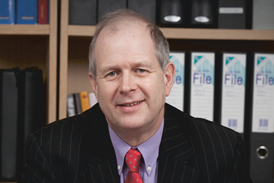Evidence Presentation: eCourt Blueprint system offers ready-made aid to help juries better understand complex cases
Cases using a new type of electronic presentation of evidence (EPE) system cut up to a third off time spent in court in London this year, a Crown Court judge claimed last week.
Other users agreed that cheaper and more flexible EPE/litigation support systems can significantly reduce time in court, saving money and potentially bringing a higher quality of justice to the courts.
Speaking at a public discussion of the technology - a kind of mix of EPE, litigation support and equipment leasing called eCourt Blueprint - Wood Green Crown Court Judge Peter Ader said that, when used in conjunction with simultaneous transcription system LiveNote, 'you are going to cut down the length of your trial by a great deal, and certainly the figure of a third would be appropriate'.
Delegates said a major plus-point of eCourt is that it is, in essence, an outsourced IT infrastructure, as well as being the software for the EPE system. The firms involved in the service, Legal Inc and Fujitsu, see it as a way of parachuting a ready-made EPE system into any court.
Mark Lucraft, a fraud law barrister at 18 Red Lion Court, agreed that a system such as eCourt can save time and be used outside of expensively provided courts, but, perhaps more importantly, provide a better quality of justice. 'A lot of people say if the case won't last more than three months, there's no point in buying the kit,' he said. However, he insisted it was worthwhile if it cuts two weeks off a six-week trial.
He added: 'I think it will enable complicated financial transactions, which form the backbone of some fraud cases, to be more easily and readily explained to a jury, [leading] to better justice if you can present evidence in a clearer form to the jury.'
But EPE is not a panacea, nor will it save time or money if is not properly used, cautioned Neil Dooley, senior solicitor at City firm Lovells.
'I think that, with the right case, there are significant savings in terms of the length of a trial, but it is far too early to say that this technology would save a third of court time as some commentators suggest,' he said.
'I suspect, however, that we will see more of this technology in courts over the next few years, though this will be a gradual change, perhaps driven by cases where almost all of the relevant documentation was generated electronically.'
An advantage of the system, said Mr Lucraft, is that 'whatever the age of courtroom you're going to, you don't have to worry about having the cabling'. This is because the eCourt set-up comes with all the infrastructure needed, provided the court has basic network cabling.
The system can be provided with a wireless network but, according to Legal Inc founder Lisa Burton, the courts and those who work in them are afraid of using wireless networks in this way. Mr Lucraft agreed that the courts are 'scared of wireless because of security' but said these fears were completely unfounded.
Links: www.legalinc.co.uk
www.fujitsu.com/uk
Charity Explorer provides a reputable reference tool for solicitors, will-writers and their clients who want to leave a legacy or charitable gift.
Visit Charity Explorer
Whether you are looking for legal expert witnesses, legal training/CPD providers, international law firms, administration of estates, legal software suppliers, barristers chambers or any other general legal service, the Legal Services Directory will provide a suitable option.
Visit Legal Services Directory

























No comments yet